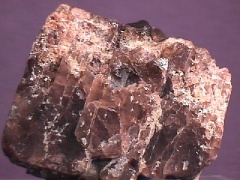Andalusite
| Infobox on Andalusite | |
|---|---|
| Example of Andalusite |  |
| Facts | |
| Origin | Desposits are found in Australia, Brazil, Canada, Russia, Spain (Andalusia, Sri Lanka and the United States of America. |
| Stowage factor (in m3/t) | 0,85 m3/t (pockets) |
| Humidity / moisture | - |
| Ventilation | - |
| Risk factors | - |
Andalusite
Contents
Description
Andalusite is an aluminium nesosilicate mineral with the chemical formula Al2SiO5.
The variety chiastolite commonly contains dark inclusions of carbon or clay which form a checker-board pattern when shown in cross-section. A clear variety first found in Andalusia, Spain can be cut into an interesting gemstone.
Faceted andalusite stones give a play of red, green, and yellow colors that resembles a muted form of iridescence, although the colors are actually the result of unusually strong pleochroism.
It is associated with mica schist which increases alkali content in ultimate product and so it has not been exploited economically so far.
Andalusite is a common regional metamorphic mineral which forms under low pressure and moderate to high temperatures. Called Lapis Crucifer in ancient texts.
The minerals kyanite and sillimanite are polymorphs of andalusite, each occurring under different temperature-pressure regimes and are therefore rarely found together in the same rock. Because of this the three minerals are a useful tool to help identify the pressure-temperature paths of the host rock in which they are found. A polymorph is a mineral that shares the same chemistry but a different crystal structure with another, or other, minerals.
Application
Constituent of sillimanite refractories, spark plug insulators, laboratory ware, superrefractories.
As a lesser-known gemstone, andalusite hasn't gained fame as of yet.











